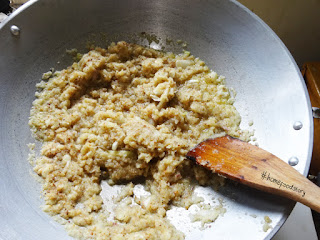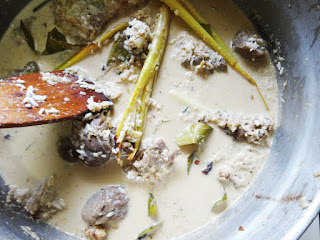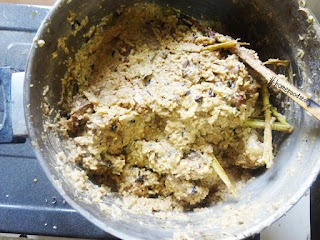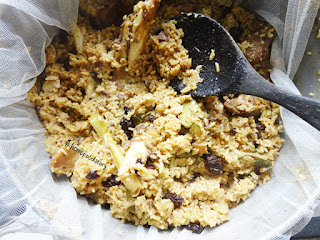What if the cuisine and culture from three regions; Middle East, Indian, and Malay mixed up? Meet this Nasi Kebuli Kambing. Been waiting for the perfect event to cook this, and finally did it for the post Eid Al Adha feast last month as the delicious main course!
Eid Al Adha, is the day where the Muslim gathers to celebrate the day of sacrifice. We begin the day by prayer and by noon we continue the holy day by sacrificing qurban to be gifted to the poor while the donors may retain one third part of the sacrificed animal. On those occasion, I chose the thigh part of the goat :9
I've told you hundred times that I, and mostly Asian, always love spiced food, haven't I? Just like I told you on the intro, this Nasi Kebuli Kambing contains it all; ginger, garlic, galangal, fennel, cumin, lemongrass, star anise, all the exotics seasonings to warm the rainy day in Bandung.
History
However, how is it ended up full of cross region various spices? The cultural background is very interesting to be followed. Long time ago, the Islam missionaries were using cuisine as one of the method to spread the religion. The missionaries, which were Middle East priests, came to India and realize that they both consume rice as daily intake. Assimilation happened, and it resulted the mixing of Arabian and Indian spices with rice, and the use of goat, mutton, or lamb meat within; which is familiarly called as Biryani Rice.
Shortly, as the merchants from India and Middle East were trading commodities in Indonesia and Malaysia, the spread of Islam was also happened there along with the culture assimilation. That was when the rice dish evolved to Nasi Kebuli that we know now. You can find the characteristic of Indonesian food in this Nasi Kebuli Kambing; galangal, coconut milk, lemongrass, cloves, emping, and pickles. The "Kebuli" word itself is believed to be "Kabuli Palaw" at first, which is an Afghani rice dish from Kabul.
Nowadays, in Indonesia, Nasi Kebuli can be found in some area where the Arabian ancestry live, such as Jakarta, Surabaya, Surabaya, and Gresik, and usually served on a big Islamic religious event such as Eid Al Adha and Eid Al Fitr. The meat that is used are vary; while the common one is using goat, another prefer chicken or beef.
About This Recipe
The attribute of Middle East and India actually remains on the common Nasi Kebuli, which is the use of ghee (Indonesian knows it as minyak samin) to saute and poured on to. However, for this recipe I substituted ghee with unsalted butter, as it was easier to be found in smallest portion. It still tasted very good, anyway :) The are many methods to cook Nasi Kebuli in this modern world, another foodb
logger are using electric rice cooker, but mine was using cooking pan and steamer.
logger are using electric rice cooker, but mine was using cooking pan and steamer.
Nasi Kebuli Kambing (Goat Kebuli Rice)
Preparation and cooking time: 3 - 4 hoursServings: 12
Ingredients:
- 1 kilogram rice, washed and cleaned
- 1 kilogram goat meat, chopped in big chunk (if you also use thigh part, do not remove the bone)
- butter, for sauteing and spreading
- 1 litre milk
- 65 ml coconut milk
- Salt and pepper
- Spices A, grind together:
- 4 onion bulb
- 5 teaspoons coriander seeds, toasted
- 3 teaspoons cumin, toasted
- 1 teaspoon fennel
- 15 cloves shallot
- 6 cloves garlic
- Seeds from 6 cardamom pods
- Spices B
- 8 sticks of lemongrass
- 10 kaffir lime leaves (how to substitute)
- 10 bayleaves
- 10 cm ginger, crushed
- 2 cm galangal, crushed (how to substitute)
- 20 star anise
- 2 cinnamon stick
- 6 cloves
- Sidedish
- Raisins
- Sliced tomato
- Pickles (skipped on for this occasion)
- Emping
Direction:
- Saute Spices A on large cooking pan until its volume reduce to half, or until it's fragrant.
- On medium heat, cook goat meat along with Spices B in, mix until the spices cover meat well. Cook meat until just medium rare.
- Pour milk, coconut milk, and clean rice in. Add salt (about 2 teaspoons) and pepper. Mix well.
- Simmer while stir the mixture periodically to make sure there is nothing left overcooked on the bottom of the pan. However, be careful on stirring the rice as it should not break the rice. This process takes about 1 hour until the liquid volume shrinks, the rice were half cooked, mushy but solid enough.
- Transfer the mixture to steamer. Steam for 45 minutes.
- After done steaming, remove from heat. Stir in butter and raisins while it's still hot.
- Serve with sliced tomato, pickles, and emping.








No comments:
Post a Comment